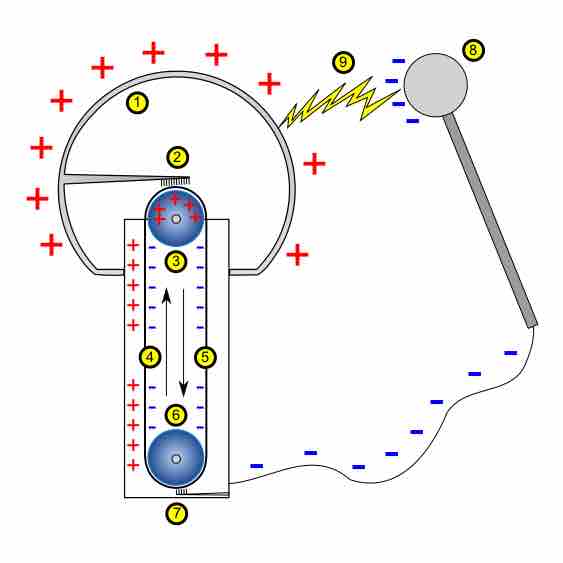A Van de Graaff generator is a device used to separate electric charges. Using a moving belt, it can create extremely high potential differences. In some cases these can reach a value in excess of five megavolts.
Fundamentally, a Van de Graaff generator consists of a flexible dielectric belt (silk is commonly used) running over two metal pulleys . One of these pulleys is surrounded by a hollow metal sphere. Two electrodes are positioned near the bottom of the lower pulley and inside the sphere, over the upper pulley. One comb is connected to the sphere, and another is connected to the ground. In this figure, a high, positive DC potential is applied to the upper roller.

Schematic of a Van de Graaff Generator
Numbers in the diagram indicate: 1) hollow metal sphere; 2) upper electrode; 3) upper roller (for example an acrylic glass); 4) side of the belt with positive charges; 5) opposite side of the belt with negative charges; 6) lower roller (metal); 7) lower electrode (ground); 8) spherical device with negative charges, used to discharge the main sphere; 9) spark produced by the difference of potentials
The separation of charge in a Van de Graaff generator is a complex, multistep process. Due to the electric field around the lower pulley, the belt receives negative charge as it passes the lower comb. When the belt comes into contact with the upper roller, it leaves the roller with a negative charge as electrons are transferred. Electrons seep from the belt to the upper comb and then the terminal, leaving the belt positively charged and the terminal negatively charged. The sphere acts as a Faraday shield, shielding the upper roller and comb from the electric field produced by charges on the outside of the sphere. Eventually, discharge occurs, and the belt changes polarity. As the belt continues, a charging current travels via the belt, and the sphere takes on more and more negative charge until the rates at which it gains and loses charge (which occurs by leakage and corona discharge) are equal. Final potential is proportional to the size of the sphere and its distance from the ground.